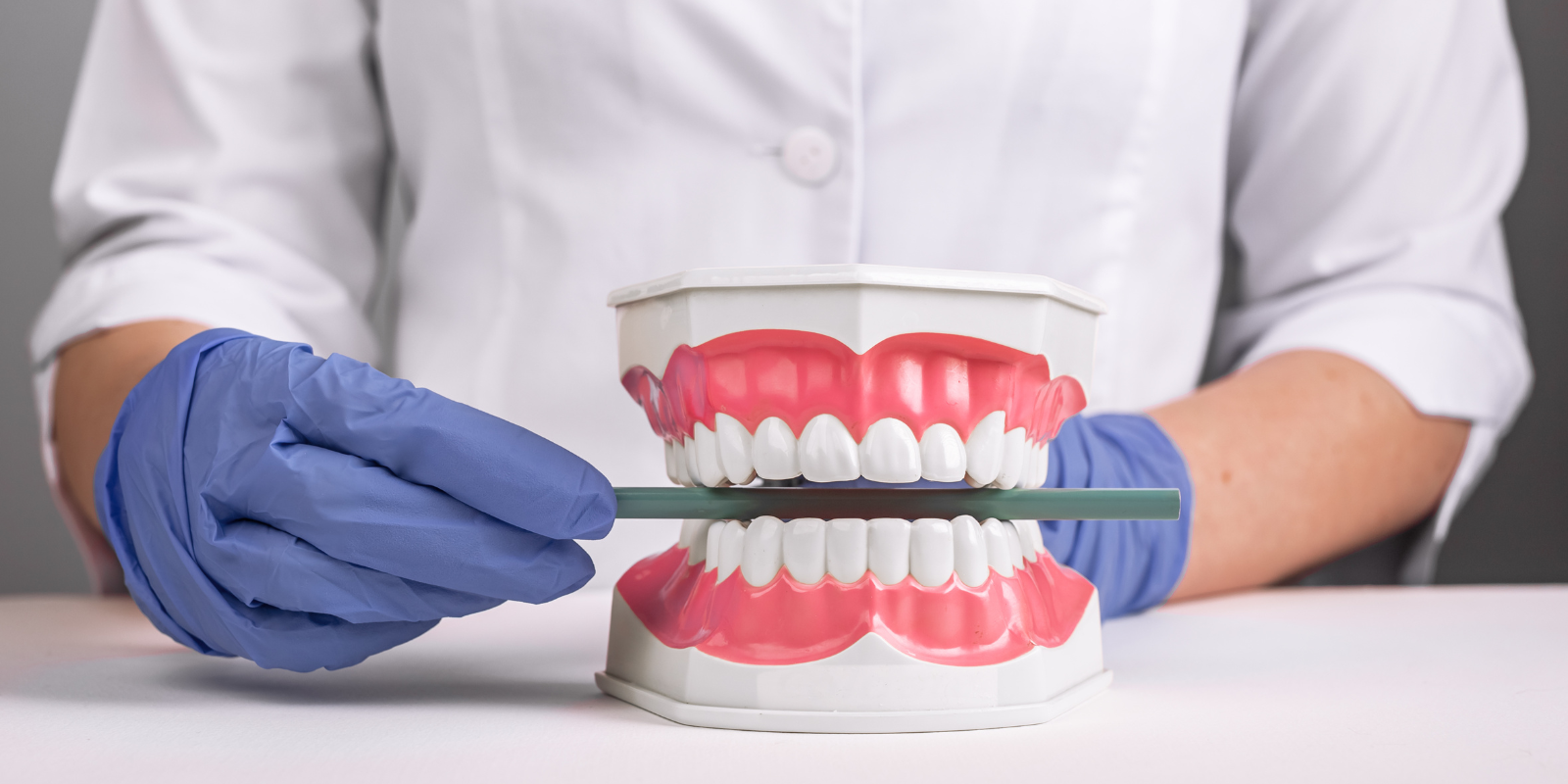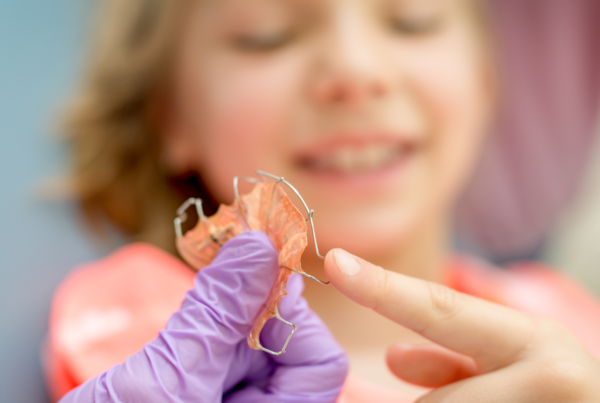
A crossbite is a type of malocclusion that involves the upper and lower teeth and can affect oral function, facial aesthetics, and overall quality of life. It occurs when the upper and lower teeth do not align properly, leading to health issues, pain, and discomfort. In this article, we explain what a crossbite is, how it is treated, what causes it, and how it can be diagnosed.
What is a crossbite and what types are there?
A crossbite is an orthodontic condition where the upper teeth sit inside the lower teeth, which is the opposite of how they should naturally align. Normally, the upper arch should slightly overlap the lower one. In a crossbite, this relationship is reversed, resulting in asymmetry and dysfunction in the bite. The lower lip often protrudes while the upper lip may appear sunken.
There are several types of crossbite. A unilateral crossbite affects only one side of the dental arch. A bilateral crossbite impacts both sides of the mouth. An anterior crossbite occurs when the upper front teeth sit behind the lower ones. A total crossbite means that all the upper teeth are positioned inside the lower teeth. A posterior crossbite happens when the lower molars sit outside the upper molars.
Crossbites can vary in severity from mild to severe, affecting both the function and appearance of the mouth and face.
What causes a crossbite?
A crossbite can result from a combination of factors, including genetics, environmental influences, and irregular development of the oral cavity and jaws. Understanding these causes helps prevent the condition and choose the most effective treatment.
- Genetic factors. Inherited jaw shapes and tooth arch sizes may lead to misalignment. If one parent has a jaw discrepancy, it is likely the child may also develop a crossbite. Genetics may also influence tooth eruption patterns, contributing to mispositioned teeth.
- Environmental factors. These are especially important during childhood when jaw development is most dynamic. Common influences include thumb sucking, prolonged pacifier use, and mouth breathing. These habits affect oral structures and can distort the dental arches, altering tooth positioning. Mouth breathing, often caused by enlarged tonsils or chronic nasal congestion, may also affect tongue posture, influencing upper jaw development.
- Jaw bone development issues. Uneven growth of the maxilla and mandible may result in a crossbite. When the upper jaw grows more slowly than the lower, the lower teeth may overlap the upper ones. Such discrepancies are often caused by childhood injuries or nutritional deficiencies, particularly in calcium and vitamin D, which are essential for bone development. This can impair the function of the bite.
- Tooth eruption. Crossbite can develop when teeth erupt in incorrect positions or order. Lack of space in the dental arch may cause teeth to grow outside their proper alignment. Delayed or premature loss of baby teeth can also lead to bite irregularities.
- Functional factors. Improper tongue posture, incorrect chewing patterns, and uneven jaw usage during eating can cause a crossbite. These habits affect the development of facial muscles that work together with the jawbones.
What are the most common symptoms of a crossbite?
Crossbite symptoms can be physical, health-related, aesthetic, and functional. Their severity depends on the age of the patient, how long the condition has been present, and the extent of the malocclusion.
Physical symptoms
These are often visible to both the patient and others. One of the most noticeable signs is facial asymmetry. The upper jaw appears narrow compared to the lower jaw. Instead of covering the lower teeth, the upper teeth sit inside them. Depending on the type of crossbite, the asymmetry may affect one or both sides. Patients may struggle to chew food evenly due to inefficient tooth alignment. This can cause them to favor one side when chewing, which puts extra stress on that side’s muscles and joints.
Health-related symptoms
These extend beyond the mouth. Uneven pressure distribution causes excessive tooth wear where forces are concentrated. Over time, enamel may weaken, increasing the risk of cavities and sensitivity. Patients may suffer from temporomandibular joint pain due to improper bite mechanics. These issues can radiate to the head, neck, and shoulders, causing muscle tension and reduced comfort. Chronic stress on the joints may lead to serious conditions like temporomandibular joint disorder (TMD), often accompanied by joint clicking and pain during mouth movement.
Aesthetic symptoms
Crossbites can affect the shape of the face and smile, leading to reduced self-confidence. Asymmetry, especially in unilateral cases, may cause psychological distress. An uneven smile and misaligned teeth can appear unattractive. This condition may also cause midline deviation, where the gap between the upper and lower central incisors is not aligned. In severe cases, the face’s proportions can become visibly altered, worsening the patient’s self-image.
Functional symptoms
Speech may be affected, with difficulties in articulating certain sounds due to incorrect tongue positioning. Swallowing issues may also occur, as the bite interferes with the natural swallowing mechanism. These difficulties can impact daily life, making communication and eating uncomfortable or embarrassing.
READ MORE: SCISSOR BITE
How is a crossbite diagnosed?
Diagnosis requires a thorough assessment by a dentist or orthodontist. During a clinical exam, the specialist evaluates tooth alignment, bite relationship, facial symmetry, and temporomandibular joint function. Crossbites are usually easy to detect due to the visible misalignment.
Modern imaging is used for precise evaluation. Panoramic X-rays assess bone structure, root positioning, and joint condition. In complex cases, CT scans may be performed for a 3D view of the craniofacial structures. Intraoral digital scans are increasingly common and provide accurate 3D models for planning treatment and tracking progress.
Patient interviews are also essential. The specialist will ask about symptoms like chewing problems, joint pain, muscle tension, or speech difficulties. In children, habits such as thumb sucking and mouth breathing are also considered.
Early diagnosis, especially in children, allows for less invasive treatment, such as removable appliances or palatal expanders. Prompt detection prevents progression and long-term complications. Regular dental check-ups are crucial in identifying bite problems early and implementing the right therapeutic steps.
What are the most effective treatments for a crossbite?
Treatment depends on the patient’s age, the severity of the condition, and individual needs. Options include orthodontic, surgical, and supportive therapies.
Orthodontic treatment for children and adolescents
When jawbones are still growing and more adaptable, orthodontic appliances are the primary treatment. Palatal expanders are commonly used to widen the upper arch and improve alignment. This method is most effective in younger patients, where bone flexibility allows for easier correction without surgery.
Orthodontic treatment for adults
For adults, where bone growth is complete, treatment is more complex. Fixed braces, including metal and ceramic versions, are standard tools. Clear aligners like Invisalign are gaining popularity due to their comfort and discreet appearance.
When orthodontics isn’t enough – surgical treatment
In severe cases, where skeletal discrepancies are present, surgery may be required. Orthognathic surgery involves repositioning the jawbones to restore bite alignment and facial balance. This is often combined with orthodontics to prepare the teeth and jaw for surgery.
Supportive therapy may include myofunctional exercises to strengthen the oral muscles and improve jaw function. Working with a speech therapist can help eliminate habits like mouth breathing. For patients with joint pain or muscle tension, relaxation techniques and physiotherapy are beneficial.
Treating crossbite requires a multidisciplinary approach
Successful crossbite treatment demands cooperation between the patient and a team of professionals. Regular visits and following orthodontic instructions are essential for lasting results. Early intervention in children is particularly important to avoid invasive treatments later on. Proper treatment not only improves smile aesthetics and facial symmetry but also restores chewing function and eliminates pain, enhancing overall quality of life. Modern treatments provide effective solutions for both children and adults, ensuring long-term bite harmony.
Summary
Now you know what a crossbite is, how it develops, and how it can be treated. This serious bite disorder can cause both functional and aesthetic issues. Early diagnosis and intervention significantly improve outcomes, restoring proper bite function, enhancing smile appearance, and increasing life comfort. Regular prevention and collaboration with experienced specialists are key to maintaining a healthy, functional bite. Visit your dental clinic to explore tailored solutions for your needs.





